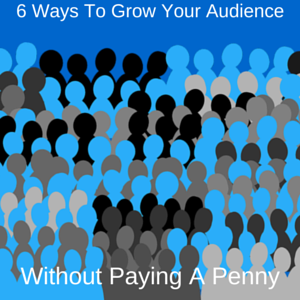
When most people think about the success of their email lists, they think about the growth of those email lists. These people ask questions like “How do I gain twice as many subscribers?” and “How do all of these top marketers get thousands of subscribers every day?”
Yes, it is important to grow your email list. I ask myself questions related to email list growth all of the time.
However, the growth of your email list is not enough. The value of your email list is more vital. As an extreme example, if you want 100,000 subscribers tomorrow, I could more than easily give you those 100,000 subscribers. I simply hire someone to create 100,000 unique email addresses and then those email addresses get added to your list.
They are fake, and an email list with 1,000 targeted subscribers would perform better than the email list with the 100,000 fake subscribers.
This example is primarily designed to establish the difference between growth and value of an email list. The results you get from your email list (i.e. clicks, sales, relationships) determine the value of that email list.
Now for a more realistic example:
Marketer #1 has an email list of 10,000 people. Of those 10,000 people, 100 of them click on the link to the blog post. Marketer #2 has an email list of 3,000 people. Of those 3,000 people, 300 of them click on the link to the blog post.
In this scenario, I would rather be Marketer #2 than Marketer #1. Size is only part of the equation. The masters of email marketing are able to get results like Marketer #2 while growing an email list like Marketer #1. How is it possible to combine the two together? This blog post shows you how.
Note for the reader: Growing your email list is important, but this blog post will be more geared towards what you do once you have the email list. If you want a blog post more focused on growing your email list, go here.
#1: Send More Emails To The People On Your List
Sending an email blast lets your subscribers see you in their inboxes. If you consistently send awesome email blasts, two things happen:
- Trust is built
- People know when to check their inboxes for your content
I know exactly when to check my inbox for Seth Godin’s content because he always publishes his blog posts at the same time of day. I figured out when he publishes his blog posts after receiving numerous emails filled with value that always landed in my inbox at the same time of day.
Sending more emails to your subscribers also means more results. Let’s say your average email gets 50 clicks from your subscribers. If you send one email blast to your list per month, then you get 600 clicks from your email list per year. However, if you send one email blast per week, then you get 2,600 clicks per year. That’s a difference of 2,000 clicks.
For some marketers, sending one email blast per month versus sending one email blast per week can be the difference between hundreds of thousands of clicks. While you shouldn’t be excessive with your email blasts, sending at least one email blast per week builds recognition between you and your subscribers.
Once the recognition is built and you continue providing value, the trust comes naturally.
#2: Resend The Same Email To The People Who Didn’t Open Your Email The First Time
Some services such as iContact make it possible for you to segment the people in your list. You can segment the people within your list to provide them with content more specific to their needs.
You can also create a segment containing a list of people who did not open your email blasts. For my most recent email blast, I will create a segment of all of the people who did not open the email. Then, I change the subject line of the email and send the identical email to those people one day later.
On the surface, this strategy resembles excessive email marketing. Sending two emails in two days may sound like a lot. However, the only people who get the email are the people who did not read your first email blast.
This is an important distinction. It is possible that some people lost your email blast within their inbox. Maybe it went into spam mail. There are many different ways that even the most loyal subscribers can skip over one of your email blasts.
If they see your email the next day, the loyal subscribers will open the email and read your message. You can also get the attention of some of your other subscribers who have not been opening as many of your email blasts.
For some marketers, this one decision has led to a 10% increase in open rate for their email blasts. In the email marketing world, a 10% increase in open rate is very significant. The best part is that you don’t have to put in any additional work to make it happen.
All you do is change the email’s subject line and resend it to the people who didn’t open the email blast the first time.
#3: Promote Your Blog Posts Within Your Autoresponders
An autoresponder is the most important part of email marketing. When people subscribe to an email list, they get a series of emails delivered to their inboxes within a few days. These autoresponder messages are designed to strengthen the relationship between you and your subscriber. After you write the messages, they run on autopilot.
Within your autoresponder messages, you can promote (almost) anything. In my autoresponder messages, I decide to promote my blog posts. The reason for my choice is that most of my email blasts promote my blog posts. The autoresponder is a way of making my subscribers more comfortable with my email blasts—high value blog posts.
If I only sent videos in my email blasts, then my autoresponder messages would only consist of videos. The autoresponder sets the tone for what type of content subscribers should expect and how the relationship will build.
For my blog, this also means consistent traffic to specific blog posts. Sometimes, I will choose to promote one of my blog posts that I know is good, but for some reason it isn’t getting as much traffic as expected. I sometimes put these blog posts within an autoresponder so they get consistent traffic.
That consistent traffic combined with social media traffic allows those blog posts to perform better on the search engines.
Your autoresponder messages are the most important messages for building a relationship between you and your subscribers. If you build the relationship right, sales will follow. Choose your autoresponder messages and the blog posts you promote within those autoresponders carefully.
#4: Write Irresistible Subject Lines
The subject line of your email blasts are just as important as the content within the email blasts themselves. The reality of email marketing is that there are only two reasons why people would open up an email:
- The subscriber automatically recognizes your name and has admired your content for a long time
- Irresistible subject line
For almost all of your new subscribers, #2 applies more often than #1. Your new subscribers learn who you are as they read more of your email blasts. Writing irresistible subject lines is an art that requires constant experimentation.
Some of the rules differ by niche but other rules are the same. The best way to discover what works is by observing what works for other people and seeing if that will work for you too. I noticed that the email marketers who used more lowercase letters got my attention.
The traditional email subject line looks like this: 5 Ways To Get More Followers
The format that gets more attention looks like this: 5 ways to get more followers
While it’s just a small difference, I gave it a try anyway. Sure enough, more people opened my email blast.
There are plenty of pull-words and other tips that you can use to write irresistible subject lines. Some of the best methods involve outside of the box thinking with this question, “How do I get their attention.”
Nowadays, including “Donald Trump” in the subject line gets massive attention. Imagine the whirlwind of attention someone would get if the subject line misspelled Trump’s name. If you want to go viral, that would work. Whether you’d want to go viral for that though is entirely up to you.
The moral of the story is that there are plenty of tips on the web for writing irresistible subject lines. However, don’t be afraid to experiment on your own and try to discover your own methods. Maybe the email blast with the subject line “Please don’t open this email” gets more opens and clickthroughs than any of your other email blasts.
Learn the tips and then expand upon them through trial and error.
In Conclusion
Growing your email list is important. The results you get from your current email list are more important. It is easy to get 100,000 fake people on your email list. It is far more difficult to get 1,000 targeted people on your email list.
How you engage with the people on your email list determines the results that you get. In the beginning, you may not get many results, but that is true with all entrepreneurial endeavors. While results don’t come often in the beginning, patient persistence brings forth the results beyond our wildest dreams.
How do you engage with your email list? Which of these tips was your favorite? What results do you want to see from your email list? Do you have any email marketing tips for us? Sound off in the comments section below.







